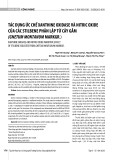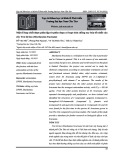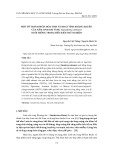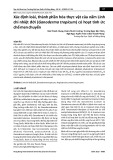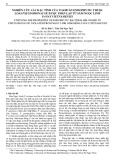
148
HNUE JOURNAL OF SCIENCE
Natural Sciences 2024, Volume 69, Issue 3, pp. 148-153
This paper is available online at http://hnuejs.edu.vn/ns
DOI: 10.18173/2354-1059.2024-0044
Microchirita bimaculata (GESNERIACEAE), A NEWLY RECORDED SPECIES
FOR THE FLORA OF VIETNAM
Ha Thi Dung1, Tran The Bach2, 3, Ha Minh Tam4,
Nguyen Mau Hoang Quan5 and Bui Thu Ha5,*
1Hanoi Crop Production and Plant Protection Sub-Department, Hanoi city, Vietnam
2Institute of Ecology and Biological Resources, Vietnam Academy of Science and
Technology, Hanoi city, Vietnam
3Graduate University of Science and Technology, Vietnam Academy of Science and
Technology, Hanoi city, Vietnam
4Hanoi Pedagogical University 2, Vinh Phuc province, Vietnam
5Faculty of Biology, Hanoi National University of Education, Hanoi city, Vietnam
*Corresponding author: Bui Thu Ha, e-mail: habt@hnue.edu.vn
Received October 4, 2024. Revised October 25, 2024. Accepted October 31, 2024.
Abstract. Plant specimens coded as Dung 051120221 at Hanoi (HN) Herbarium of
the Institute of Ecology and Biological Resources, were identified as Microchirita
bimaculata (D. Wood) A. Weber & D. J. Middleton. This is a newly recorded species
for the flora of Vietnam. The morphological comparison method is applied
appropriately in the study. Microchirita in Vietnam includes 8 updated species: M.
aratriformis (D. Wood) A. Weber & D. J. Middleton, M. bimaculata (D. Wood) A.
Weber & D. J. Middleton, M. hamosa (R. Br.) Yin Z. Wang, M. involucrata (Craib)
Yin Z. Wang, M. lavandulacea (Stapf) Yin Z. Wang, M. minor Z. B. Xin, T. V. Do
& F. Wen, M. purpurea D. J. Middleton & Triboun, M. rupestris (Ridl.) A. Weber
& D. J. Middleton. M. bimaculata is distinguished from the remaining 7 species by
the characteristics of ”bracts absent; corolla yellow with a red-brown patch inside”.
The identification key for species of the genus Microchirita currently known in
Vietnam was established. M. bimaculata in Vietnam has been described in detail
with accepted scientific name, synonym, morphological description, loc. class.,
typus, ecology, flower and fruit season, distribution, research sampling, images.
Keywords: Microchirita bimaculata, Gesneriaceae, Dak Nong, Vietnam, Thailand.
1. Introduction
The genus Microchirita (Gesneriaceae) is distributed from southern China to tropical
Asia and includes 48 accepted species (POWO 2024) [1]. In Vietnam, there are 7 recorded

Microchirita bimaculata (Gesneriaceae), a newly recorded species for the flora of Vietnam
149
species [2]-[5] including M. aratriformis (D. Wood) A. Weber & D. J. Middleton, and
M. hamosa (R. Br.) Yin Z. Wang, M. involucrata (Craib) Yin Z. Wang, M. lavandulacea
(Stapf) Yin Z. Wang., M. minor Z.B.Xin, T.V.Do & F.Wen, M. purpurea D.J.Middleton
& Triboun and M. rupestris (Ridl.) A.Weber & D.J.Middleton.
During studying samples at the HN Herbarium (Thiers 2024) [6], Institute of Ecology
and Biological Resources and documents, plant specimens with the code Dung
051120221 (HN) were preliminarily identified as Microchirita bimaculata, which has yet
recorded in Vietnam.
Microchirita bimaculata is a supplementary species in Vietnam's flora, playing an
essential role in maintaining and enhancing biodiversity [7]. Although this species is
currently not common, it significantly contributes to the ecosystem through genetic
diversity, ecological balance, and environmental improvement. In the context of climate
change and human impacts, Microchirita bimaculata and similar species support
ecosystem resilience and adaptability.
The study of morphological characteristics of the specimens is necessary for their
identification as M. bimaculata (D. Wood) A. Weber & D. J. Middleton. This is a newly
recorded species for the flora of Vietnam.
2. Content
2.1. Materials and Methods
Materials: Specimens of Microchirita in Vietnam are stored in Hanoi Herbarium,
Institute of Ecology and Biological Resources, Vietnam Academy of Science and
Technology.
Methods: The morphologically compared method is used for the study. Major
morphological characteristics are observed, described, recorded, and compared with other
specimens of Microchirita and relevant documents [2]-[4]. An identification key has been
established for Microchirita in Vietnam. Based on the key, the scientific name and
description of the species was determined. Morphological characteristics of specimens
coded as Dung 051120221 were compared with type specimens and original
morphological description of Microchirita immaculate.
2.2. Results
2.2.1. Morphological description of Microchirita bimaculata (D. Wood) A. Weber &
D. J. Middleton
Taxon 60(3): 778 (2011); C. Puglisi & D.J. Middleton, Gardens' Bulletin Singapore
69(2): 224-228 (2017).
Synonym. Chirita bimaculata D. Wood, Notes Roy. Bot. Gard. Edinburgh 31: 368
(1972); Wood, Notes Roy. Bot. Gard. Edinburgh 33: 196 (1974); Burtt, Thai Forest Bull.,
Bot. 29: 87 (2001).

Ha TD, Tran TB, Ha MT, Nguyen MHQ & Bui TH
150
Herb: 50 cm tall, internodes 2-10 cm long. Stems: succulent, unbranched. Leaves:
usually opposite, apart from the basal leaf; petiole 0.2-2.5 cm long, pubescent; leaves
green above, light green below, lanceolate or ovate, 3.2-30 × 1.4-19 cm; base cordate,
rounded or attenuate; apex acuminate or acute; upper surface pubescent, lower surface
glabrous or pubescent; leaf margins without hairs or with few hairs, entire; secondary
veins 8-15 paired. Inflorescences: the peduncle is reduced to 15 mm long and usually
grows along the petiole; bracts absent; the petiole is 5-20 mm long and pubescent; bud
apex truncate or acuminate outside pubescent; flowers bilaterally symmetrical. Calyx:
tube 0.3-1 mm long; lobe elliptic or lanceolate to linear, tip outside and margin pubescent,
5-10 × 0.7-1.8 mm; apex acuminate; margin entire, occasionally toothed. Corolla: to 21
mm long; petals fused, upper lip 2 lobes, lower lip 3 lobes; yellow with a red-brown patch
(consisting of two red-brown spots fused) inside, pubescent; base of tube glabrous,
broader part sparsely hairy; tube 10-19 mm long; lobes broadly elliptic, apex rounded,
pubescent, upper lobes 1-4 × 2.5-5.1 mm, lateral lobes 2.5-5 × 3.3-6 mm, lower lobes 2.3-
5.2 × 2.5-7.5 mm. Stamens: arising 5-11 mm above the corolla base; filaments straight,
glabrous, 2-2.6 mm long, 0.2-0.6 mm wide; anthers pubescent, 1.1-2 × 0.6-1.1 mm. Disk:
0.2-0.9 mm high, white, glabrous. Pistil: 11.5-15 mm long; ovary 2-6 mm long, apex
pubescent; style 5-7.5 mm long, pubescent; stigma 0.5-1.1 mm long, glabrous except for
the hairy margin. Fruit: 1.5-5 cm long, 1.2-2 mm in diameter, usually curved, sometimes
straight. Seeds: brown, narrowly elliptic, 0.3-0.4 × 0.1 mm.
Loc. class.: Thailand, Mae Klang Waterfalls, c. 50 km Southwest of Chiang Mai,
c. 430 m.
Typus: Burtt, B.L. 5611 (holotype photo E [E00155280]).
Ecology, flower, and fruit season: In both Thailand and Vietnam, specimens of the
species were collected at waterfalls. Flower and fruit season in November.
Distribution: India, Laos, Thailand. In Vietnam, species are found in Dak Nong
(Dray Nur Waterfall).
Research specimens: Dak Nong (Dray Nur Waterfall), 5/11/2022, Ha Thi Dung,
Dung 051120221 (HN Herbarium).
2.2.2. Identification key of genus Microchirita in Vietnam
1A. Bracts present
2A. Corolla violet, blue or red; corolla tube longer 12 mm ...................M. involucrata
2B. Corolla white; corolla tube shorter 7 mm ...........................................M. rupestris
1B. Bracts absent
3A. Corolla yellow with a red-brown patch (consisting of two red brown spots fused)
inside ….………………………………………………..……..M. bimaculata
3B. Characteristics of the corolla are not as above
4A. The outer corolla lobes white

Microchirita bimaculata (Gesneriaceae), a newly recorded species for the flora of Vietnam
151
5A. The inside of the corolla with yellow vertical stripes; pistil 6-8 mm long, ovary
2-3 mm long ........................................................................M. hamosa
5B. The inside of the corolla without yellow vertical stripes; pistil about 16 mm long,
ovary 14 mm long ....................................................M. minor
4B. The outer corolla lobes are not white
6A. The outer corolla tube is partly or completely white ......................M. aratriformis
6B. The outer corolla tube is violet, purple
7A. Ovary glabrous, style glabrous .........................................................M. purpurea
7B. Ovary pubescent, style pubescent ................................................M. lavandulacea
Figure 1. Morphology of Microchirita bimaculata’s stems and leaves
A, B. flowering and fruiting branch, unbranched stem; C, D. leaves, inflorescences,
fruits; E. leaf base (Photos: Vu Anh Thuong, 2024)

Ha TD, Tran TB, Ha MT, Nguyen MHQ & Bui TH
152
Figure 2. Morphology of Microchirita bimaculata’s flowers
A. apex of flower bud truncate; B. apex of flower bud acuminate; C-E. calyx; G-H.
bilaterally symmetrical flowers, petals fused, upper lip 2 lobes, lower lip 3 lobes; I-L.
corolla opened (K: consisting of two red-brown spots fused)
(Photos: Vu Anh Thuong, 2024)
Figure 3. Morphology of Microchirita bimaculata’s stamens and pistil
A
-C. filament straight, anther pubescent; D. calyx opened, pistil; E. pistil; G. disk
at the base of ovary; H-I. style and stigma
(Photos: Vu Anh Thuong, 2024)


